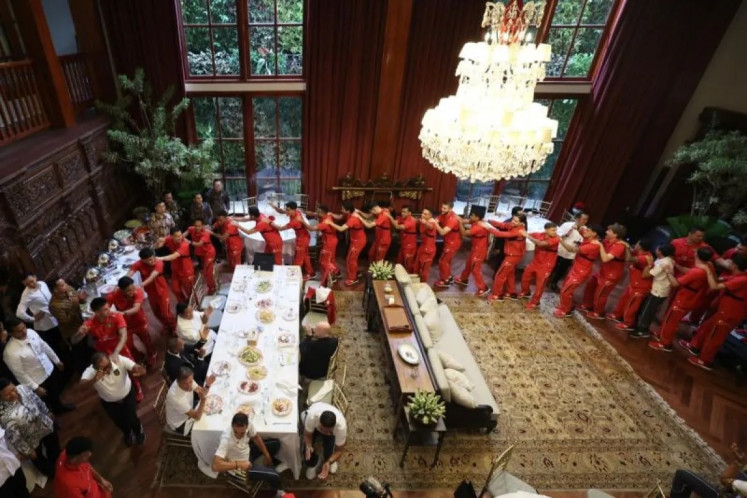Popular Reads
Top Results
Can't find what you're looking for?
View all search resultsPopular Reads
Top Results
Can't find what you're looking for?
View all search resultsMore than just satay: Indonesian food and its common misconceptions
Walking through the many boroughs of London, there are lively Asian diaspora communities that have cemented their place in the city as a home away from home. From the floating red lanterns strewn across Chinatown near Leicester Square to the Asian food halls, it isn’t difficult to adapt to life in the big city.
Change text size
Gift Premium Articles
to Anyone

I
t is not hard to find a place to eat in London. It is a melting pot of cultures and cuisines, filled with exotic ingredients and aromatic spices.
Walking through the many boroughs of London, there are lively Asian diaspora communities that have cemented their place in the city as a home away from home. From the floating red lanterns strewn across Chinatown near Leicester Square to the Asian food halls, it is not difficult to adapt to life in the big city.
Continue your journey through central London to the business district, where glass skyscrapers glitter in the sky and people run about in monochrome office attire.
There are restaurants selling inexpensive Asian food right by the nearest Pret café, serving takeaway dishes of Asian food remodeled to be “healthier” (as if it wasn’t to begin with). A word to describe these pan-Asian food chains is inauthentic. You’ll find Korean fried chicken in a Japanese fast-food chain, or satay skewers on a Thai restaurant menu.
For many who have been on the hunt for good Indonesian food in London for years, authentic Indonesian food (let alone authentic Balinese food) is hard to come by.
Considering Indonesia’s archipelago, made up of over 17,000 islands, it is no surprise that Indonesian food cannot be represented with a single dish. And even if it could, there would be over a hundred different ways to make it.
Take satay, a token dish recognized around the world. According to Rahel Stephanie, founder of supper club Spoons, there are up to 252 ways to cook satay. Unfortunately, this has led to inauthentic satay dishes around the city.
“You’ll find satay rice boxes, satay sauces and satay salads – all with no skewer in sight,” Stephanie says in an interview with Delicious Magazine.
As an Indonesian, our representation is near nonexistent. Of course, you have the hidden gems in the form of delivery services, pop-ups and a few restaurants, but our national dishes are barely talked about in the United Kingdom.
Even as the Indonesian community in London slowly grows, there are still instances where restaurants are strictly Indo-Chinese-Malay fusion foods.
Despite the almost identical national languages of Indonesia and Malaysia and the recurring ingredients found in each cuisine, each nation is special in its own way. They should not be mixed together into a few watered-down dishes that barely hold their original flavors.
Maybe a restaurant setting is the best way to introduce new, unfamiliar cuisines to people in the UK.
Somewhere in St. James, Southwest London, there is Toba, a restaurant that has been the talk of the town for the past few months among the Indonesian community. The restaurant is owned by Pino Edward Sinaga, known for his Camden market stall Pino’s Warung, which has been operating for about four years.
When asked about the popularity of Indonesian food in the UK, Pino implied there was still a long way to go. He said that one of his biggest obstacles in running food outlets was sourcing the ingredients. “We get most of our spices imported from the Netherlands, where the Indonesian community is more prominent,” he says.
But after the restaurant’s opening earlier this year, Toba has been buzzing with an onslaught of reservations, positive reviews, including one from The Guardian and most importantly a lasting impression on non-Indonesians who have never delved into Indonesian food past satay with peanut sauce. To add, Pino said that 60 percent of his restaurant customers were non-Indonesian.
The restaurant menu consists of familiar food for non-Indonesians and newer dishes that are reminiscent of Pino’s own upbringing. Among the dishes, ikan arsik (a spicy fish dish) is one of Toba’s bestselling items.
“It’s a fillet of cod, cooked in a Bataknese style, which is where I’m originally from. It’s a recipe from my beloved late mother,” he explained.
Pino said that his restaurant and his stall had stark differences in the demographic of customers. Unlike his restaurant, 60 percent of the people coming to his stall were Indonesian, and unlike Toba’s menu, Pino’s Warung sells comforting street food served on paper plates. Sinaga told me that his bestselling dishes in Pino’s Warung were nasi padang, a flavorful rice dish originating from West Sumatra, and satay ayam (grilled chicken skewers).
Unlike the elegant interior of the restaurant and the smartly dressed staff, Pino’s Warung is laid-back and tucked away from the chaos of Camden. Among the plethora of Indo-fusion foods around the city, Pino’s Warung is one of the few authentic Indonesian food spots in London.
Reconstructed and recognized
Of course, reinvented or reconstructed dishes are not always a bad thing, as long as the cuisine’s history and flavors are taken into consideration. In Rahel Stephanie’s supper club Spoons, she serves reinterpretations of traditional Indonesian dishes to make them plant-based while maintaining their authentic flavor. With her platform, she promotes Indonesian culture through British television appearances, while sharing her vegan-friendly recipes to news outlets like The Guardian.
Given Indonesia’s meat-heavy dishes, Rahel often recreates these foods with plant-based versions of them. She said in an interview with Delicious Magazine, “What frustrates and angers me is the appropriation of foods without attention given to the cultural and historical contexts. It’s so disrespectful to centuries of tradition and will eventually lead to their erasure.”
Now, in an age where people seek authenticity in different cultures and where Asian cuisines are slowly being appreciated in the West, perhaps Indonesian cuisine and the culture will be recognized in due time.
Nestled within the Queensway market sits a small red café, named Triple Hot Spicy Café. Inside are posters of Indonesian desserts and the café’s menu of rice dishes and soups.
By the kitchen is an array of imported goods you will not find in London’s supermarkets. The tables in the café are usually occupied by families indulging in the café’s specialty dish, bakso, a meatball soup paired with noodles and leafy greens. There are bottles of sambal and sweet soy sauce on the table for customers to make their own bakso concoction, all according to personal preferences.
Running this café is Zukni Legowo, who has been living and raising his family in the UK for the last 25 years. Hopping from cities like Manchester all the way to Ireland, he spent 10 years serving bakso in food bazaars and via delivery services before setting up shop in London, where he opened Triple Hot Spicy Café.
“I opened the café two years ago, during the pandemic. I took a risk despite the situation [back then], where I watched smaller businesses shut down,” he said. Now, Zukni proudly expresses the success of the café, recently opening a new branch in Bicester Village, Oxfordshire.
“It has been growing slowly, because right now the UK is going through an economic recession,” he said, although he was optimistic about the cafés and their development in the future.
Just like the small community of Indonesian restauranteurs in the UK, Zukni is rooting for the growing popularity of Indonesian food and culture in the West. He said he wants to serve the most authentic version of Indonesian food to introduce to people in the UK.
“Indonesia’s culinary landscape is still behind in the UK, compared with our neighboring countries like Malaysia, Thailand or Vietnam,” he said. “In my opinion, Indonesian cuisine has so many flavors and variations, and it’s something I want to show to people overseas.”
Unsurprisingly, most of his customers are Indonesians, but Zukni said there had been more non-Indonesians stopping by. Recently there had been more Southeast Asians, like Malaysian and Indian visitors, with Zukni explaining that they usually enjoyed the food as much as his usual Indonesian customers did.
“We want to use food as a way to introduce the general public of the UK to Indonesian culture,” Zukni said
With the growth of the Indonesian community in the UK, he was optimistic about the West’s growing recognition of Indonesian culture.
He said, “I hope that in the future, our Indonesian customers can recommend Indonesian food to their friends, and in five or 10 years ahead, I hope the awareness of Indonesian food in England is more widely known.”









